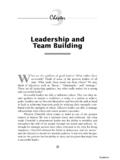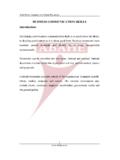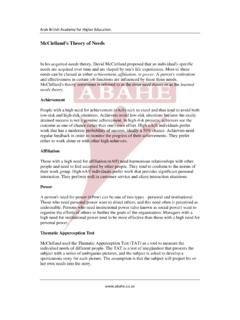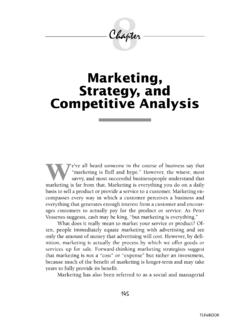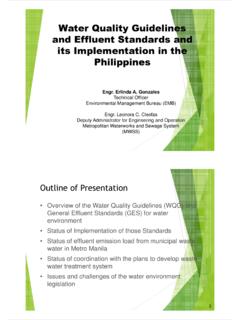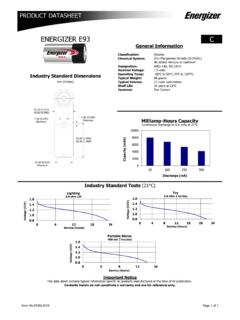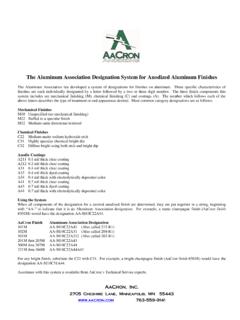Transcription of Quality Management Systems - ABAHE
1 14 QualityManagementSystemsFor more than two decades Quality and Quality manage-ment Systems have been leading buzzwords in the busi-ness world. Numerous consultants have built their careersaround these topics, and Quality issues in business have been re-sponsible for the development of new organizations and even indus-tries, for instance, the American Society for Quality and Six notion of Quality in business focuses on the savings and addi-tional revenue that organizations can realize if they eliminate errorsthroughout their operations and produce products and services at theoptimal level of Quality desired by their customers. Errors can take al-most any form for example, producing the wrong number of parts,sending bank statements to customers who have already closed theiraccounts or sending an incorrect bill to a client.
2 All of these errors arevery common, and the costs incurred seem minimal. But over timewhen mistakes are repeated the costs add up to a significant amount,so eliminating errors can result in significant increases to the bottomline of a IS Quality ?According to the American Society for Quality , Quality can be de-fined in the following ways: Based on customer s perceptions of a product/service s designand how well the design matches the original specifications. The ability of a product/service to satisfy stated or impliedneeds. Achieved by conforming to established requirements withinan Is a Quality Management system ?A Quality Management system is a Management technique used tocommunicate to employees what is required to produce the desiredquality of products and services and to influence employee actions tocomplete tasks according to the Quality Purpose Does a Quality Management system Serve?
3 Establishes a vision for the employees. Sets standards for employees. Builds motivation within the company. Sets goals for employees. Helps fight the resistance to change within organizations. Helps direct the corporate Is Quality Important?Business success may simply be the extent to which your organizationcan produce a higher- Quality product or service than your competi-tors are able to do at a competitive price. When Quality is the key to acompany s success, Quality Management Systems allow organizationsto keep up with and meet current Quality levels, meet the consumer sQuality Management Systems265 TLFeBOOK requirement for Quality , retain employees through competitive com-pensation programs, and keep up with the latest OF THE Quality MOVEMENTAs early as the 1950s, Japanese companies began to see the benefits ofemphasizing Quality throughout their organizations and enlisted thehelp of an American, W.
4 Edwards Deming, who is credited with givingJapanese companies a massive head start in the Quality movement. Hismethods include statistical process control (SPC) and problem-solvingtechniques that were very effective in gaining the necessary momen-tum to change the mentality of organizations needing to produce high- Quality products and services. Deming developed his 14 points(Appendix ) to communicate to managers how to increase qualitywithin an believed that 85 percent of all Quality problems werethe fault of Management . In order to improve, Management had totake the lead and put in place the necessary resources and example, consistent Quality in incoming materials could not beexpected when buyers were not given the necessary tools to under-stand Quality requirements of those products and services.
5 Buyersneeded to fully understand how to assess the Quality of all incomingproducts and services, understand the Quality requirements, as wellas be able to communicate these requirements to vendors. In a well-managed Quality system , buyers should also be allowed to workclosely with vendors and help them meet or exceed the requiredquality to Deming, there were two different concepts ofprocess improvement that Quality Systems needed to address: (1)common (systematic) causes of error, and (2) special causes of causes are shared by numerous personnel, machines, orproducts; and special causes are associated with individual employ-ees or equipment. Systematic causes of error include poorproduct/service design, materials not suited for their use, improperbills of lading, and poor physical conditions.
6 Special causes of errorinclude lack of training or skill, a poor lot of incoming materials, orequipment out of AND PROCESSES266 TLFeBOOKA nother influential individual in the development of Quality con-trol was Joseph M. Juran, who, like Deming, made a name for himselfworking in Japanese organizations focusing on improving Quality . Ju-ran also established the Juran Institute in 1979; its goals and objectiveswere centered on helping organizations improve the Quality of theirproducts and defined Quality as fitness for use, meaning that the usersof products or services should be able to rely on that product or service100 percent of the time without any worry of defects. If this was true,the product could be classified as fit for of designcould be described as what distinguishes a Yugofrom a Mercedes-Benz and involves the design concept and specifica-tions.
7 The Quality of a product or service is only as good as its designand intention. Thus, it is important to include Quality issues in the de-sign process, as well as to have in mind during the design phase thedifficulties one might have in replicating the product or service withthe intended Quality of conformanceis reflected in the ability to replicate eachaspect of a product or service with the same Quality level as that in-tended in the design. This responsibility is held by individuals to de-velop the processes for replication, the workforce and their training,supervision, and adherence to test to freedom from disruptive problems through-out the process and is measured by the frequency or probability of de-fects for example, if a process does not have a steady flow ofelectricity and this causes defective parts, or when an employee mustcomplete two jobs at once and is therefore forced to make concessionson the Quality of both products or described by Juran as calculating the risk of injury due toproduct hazards.
8 For example, even if the product or service meets orexceeds all Quality standards and expectations, but there is a possibilitythat if it is not used properly it could injure someone, the product willnot be considered userefers to the ability of the product to reach the end userwith the desired level of Quality . This involves packaging, transporta-tion, storage and field service competence, and also developed a comprehensive approach to Quality that spanned a product or service s entire life cycle, from design toQuality Management Systems267 TLFeBOOK customer relations and all the steps in between. Juran preached thatan organization should dissect all processes and procedures from aquality perspective and analyze for a fitness for use.
9 Once this iscompleted the organization can begin to make changes based on the fitness for use Quality Revolution Comes to the United StatesThe push for increased Quality began in American manufacturing com-panies in the 1980s, following in the footsteps of Japanese manufactur-ers. Japanese companies found themselves with a distinct competitiveadvantage over American companies with their ability to producemuch higher Quality products with fewer Ford Motor Company was the first to invite Deming to helpthe company transform itself into a Quality -oriented organization. Asa result, Ford was able to achieve higher Quality standards than anyother American automotive manufacturer and substantial salesgrowth in the late 1980s even when the rest of the automotivemarket was declining.
10 Ford attributes the ability of its Taurus to over-take the Honda Accord in annual sales to the high Quality standardsset by the Congress, seeing the need for American companies tostrive for increased Quality , established the Malcolm Baldrige NationalQuality Award, modeled after Japan s Deming Prize. This spawned asubstantial increase in the resources American businesses allocatedfor Quality improvement, and within 10 years an American organiza-tion, Florida Power and Light, was able to capture Japan s DemingPrize for the early 1980s and on into the twenty-first century, qualityissues have surfaced in every industry and almost every organization inthe United States.

